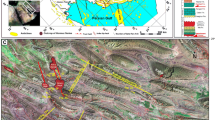Abstract
The northeastern part of the Tabriz, Khaje area has been studied to determine the relationship between the orientation of local structures and regional tectonics, and the influence of both on salt deformation. All the pre-Pliocene sedimentary rocks in the area belong to the Miocene Upper Red Formation. Sandstones form most of the outcrops because the other main components of the formation, marl and gypsum, are easily eroded and therefore recessive. The small thickness of sedimentary rock overlying the salt layer indicates that buoyancy of the salt was not the main factor causing diapirism. Folds related to the main faults of the region have been formed as result of the compressive tectonic forces. Two compressive stress systems have operated in the study area. In the first one, the direction of principal stress was NE‒SW and the resulting geological structures have an approximate E‒W trend. This stress system also controlled the salt tectonics in the region. The principal stress in the second system was oriented NW‒SE and is responsible for the most recent structures. The stress systems also caused rapid salt movement. The Khaje diapir is characterized by a series of salt walls trending NW‒SE that has been caused by the first stress system. This diapirism was principally the result of compressive tectonic stresses and faulting, particularly related to the North Tabriz Fault.









Similar content being viewed by others
REFERENCES
A. Agha-Nabati, Geology of Iran (Geol. Suv. Iran, Tehran, 2006).
A. Alizadeh, “Active faults on the satellite image of Azerbaijan Province, northwestern Iran,” Geoinformatics Geostat.: Overview 3, 1–4 (2013).
A. Alizadeh and Z. Hoseynalizadeh, “Analysis of the stress regime and tectonic evolution of the Azerbaijan Plateau, Northwestern Iran,” Geotectonics 51, 308‒318 (2017).
A. Alizadeh and F. Jangjoo, “Wedge-shaped pop-up structure in the Eslami Peninsula, Lake Urmia, Northwestern Iran,” Acta Geol. Sin. (Engl. Ed.) 91, 1264‒1269 (2017).
A. Alizadeh, M. Lopez Martinez, and K. Sarkarinejad, “40Ar-39Ar geochronology in a gneiss dome within the Zagros Orogenic Belt,” C. R. Geosci. 342, 837‒846 (2010).
M. Arian and H. Noroozpour, “Tectonic geomorphology of Iran’s salt structures,” Open J. Geol. 5, 61‒72 (2015).
M. Behyari, M. Mohajjel, E. R. Sobel, M. Rezaeian, M. Moayyed, and A. Schmidt, “Analysis of exhumation history in Misho Mountains, NW Iran: Insights from structural and apatite fission track data,” J. Geol. Paleontol. 283, No. 3, 291‒308 (2017).
M. Ghorbani, The Economic Geology of Iran (Springer, Berlin, 2012).
M. Heidari, M. A. Nikolinakou, M. R. Hudec, and P. B. Flemings, “Geomechanical analysis of a welding salt layer and its effects on adjacent sediments,” Tectonophysics 683, 172‒181 (2016).
M. P. A. Jackson, R. R. Cornelius, C. H. Craig, A. Gansser, J. Stöcklin, and C. J. Talbot, Salt Diapirs of the Great Kavir, Central Iran, Vol. 177 of Geol. Soc. Am., Mem. (1990).
N. McQuarrie and D. van Hinsbergen, “Retrodeforming the Arabia-Eurasia collision zone: Age of collision versus magnitude of continental subduction,” Geology 41, 315‒318 (2013).
M. Mortazavi, S. Heuss-Assbichler, and M. Shahri, “Hydrothermal systems in the salt domes of south Iran,” Procedia Earth Planet. Sci. 17, 913‒916 (2017).
M. Reuter, W. E. Piller, and M. Harzhauser, “Comment on ‘Revision of the age of the Qom Formation in the Central Iran Basin, Iran,’ by Zhu et al. (Journal of Asian Earth Sciences, 2007, vol. 29, 715–721),” J. Asian Earth Sci. 34, 699–701 (2009).
D. D. Schultz-Ela, M. P. A. Jackson, and B. C. Vendeville, “Mechanics of active salt diapirism,” Tectonophysics 228, 215‒312 (1993).
B. C. Vendeville, and M. P. A. Jackson, “The rise of diapirs during thin-skinned extension,” Mar. Pet. Geol. 9, 331‒353 (1992).
D. Waltham, “Why does salt start to move?,” Tectonophysics 282, 117‒128 (1997).
Y. Yamada, H. Okamura, Y. Tamura, and F. Tsuneyama, “Analog models of faults associated with salt doming and wrenching: Application to offshore United Arab Emirates,” in Faults, Fluid Flow, and Petroleum Traps, Vol. 85 of AAPG Mem., Ed. by R. Sorkhabi and Y. Tsuji, (Am. Assoc. Pet. Geol., 2005), pp. 95‒106.
A. Yousefi-Bavil and M. Moayyed, “Paleo and modern stress regimes of central North Tabriz Fault, Eastern Azerbaijan Province, NW Iran,” J. Earth Sci. 26, 361‒372 (2015).
B. Zamani, G. Jalilpour, M. Moayyed, and M. Faridi, “Structural study of Khaje salt diapir in the NE of Tabriz, research possibility of gas storage potential and analytical modeling of diapirism,” Geosciences 24, 217‒226 (2015).
ACKNOWLEDGMENTS
We acknowledge the support of Urmia University and facilities provided by the Geology Department.
Author information
Authors and Affiliations
Corresponding author
Additional information
Reviewer: V.G. Trifonov
Rights and permissions
About this article
Cite this article
Alizadeh, A., Behyari, M. & Golandam, H. Structural Evolution and Halokinesis of Khaje Salt Diapir, North‒West of Iran. Geotecton. 53, 533–540 (2019). https://doi.org/10.1134/S0016852119040022
Received:
Revised:
Accepted:
Published:
Issue Date:
DOI: https://doi.org/10.1134/S0016852119040022




